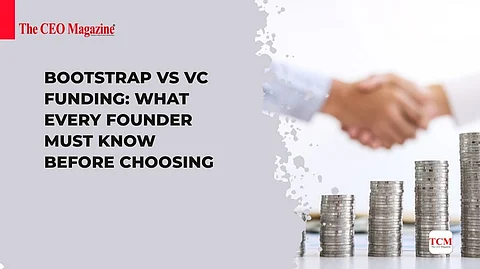
- News
- Women
- Magazine
- IndustryIndustry
- InsightsInsights
- Success Stories
- PublishPublish
- ContactContact
- Media KitMedia Kit

Bootstrap vs VC Funding: What Every Founder Must Know Before Choosing
Let me guess — you’ve got a game-changing idea, a powerful vision, and the hustle to back it up.
Now comes the real dilemma:
Should you bootstrap or raise venture capital (VC) funding?
This isn’t just a financial decision.
It’s a decision about freedom vs. fuel, control vs. speed, long-term ownership vs. rapid scaling.
I’ve spoken with hundreds of startup founders across India and globally — from solopreneurs building out of their living rooms to Series B trailblazers with global ambitions.
And let me tell you: there’s no one-size-fits-all answer.
But there is a right answer for you.
Let’s walk through how to find it.
Choosing between bootstrapping and VC funding will shape:
How fast you grow
How much control you retain
How much risk you take
And ultimately, how your startup story ends
“The money you raise will shape the company you build.” — Naval Ravikant
So don’t just follow trends.
Let’s unpack what each path really looks like — the truth behind the buzzwords.
Bootstrapping means growing your business using your own resources — savings, revenue, or reinvested profits — without outside investors.
Full control: You’re the boss — no dilution, no board approvals.
Profit focus: You build a sustainable business from Day 1.
Creative freedom: Pivot fast, test ideas without pressure.
Limited resources: Growth may be slower without external capital.
Founder stress: You're managing risk alone.
Scaling challenges: Entering new markets or building tech at scale can be tough.
Zoho, one of India’s most respected SaaS companies, is famously bootstrapped.
Founder Sridhar Vembu focused on long-term profitability and product quality over fast VC-fueled growth — and built a billion-dollar empire on his own terms.
Venture capital funding involves raising money from institutional investors in exchange for equity — and often, some control.
Speed to scale: You can hire, build, and expand quickly.
Market dominance: Get ahead of competitors fast.
Network access: Investors bring mentorship, connections, and credibility.
Dilution of control: You’ll have to share equity and decision-making.
Pressure to grow fast: VC expectations can push you toward unsustainable growth.
Exit expectations: Most VCs want an exit (IPO or acquisition) — your dream may not be theirs.
Flipkart started as a small e-commerce site. After raising VC rounds, it scaled aggressively — ultimately selling to Walmart for $16 billion.
VC backing gave them speed, but also pushed them toward high-stakes growth and strategic exits.
Let me help you map this out clearly.
Ask yourself these 7 founder questions:
High-margin, niche, long-term play? → Consider bootstrapping.
Low-margin, winner-takes-all market? → VC may be essential.
Willing to take it slow and steady? → Bootstrap.
Need to grab market share quickly? → VC.
Yes? You’ll love bootstrapping.
No problem sharing vision with others? VC could work.
Comfortable with personal financial risk? Bootstrap.
Prefer spreading risk with backers? VC funding helps.
Lifestyle business or legacy builder? Bootstrap is gold.
Hyper-growth and exit strategy? VC is aligned.
Quality, depth, and focus? Bootstrapped startups often deliver better.
Speed, expansion, and disruption? VC-backed startups can dominate.
Prepared to wear multiple hats? Bootstrap mode suits you.
Want a team fast and scale ops quickly? VC capital helps hire and build.
Here’s the secret: it’s not always either/or.
Many successful founders:
Bootstrap until product-market fit
Then raise VC money to scale
This gives you leverage, proof, and better investor terms.
Freshworks bootstrapped its early days out of Chennai.
Only after proving value did they raise from Accel and Sequoia — eventually going public on NASDAQ.
So if you’re unsure, bootstrap smart, fundraise later.
If you choose the bootstrapped path, here’s how to play it like a pro:
Start lean, but think big
Focus on cash flow from Day 1
Reinvest profits, not ego
Automate and outsource strategically
Build community and brand early
Pro Tip: Use customer feedback as your “investor deck.” Let real demand shape your growth.
If you’re leaning toward VC funding, don’t just chase money — choose the right investor.
Pitch with clarity and urgency
Find a values-aligned VC — not just deep pockets
Negotiate control, not just valuation
Understand liquidation preferences and cap tables
Build milestones, not dreams
Pro Tip: Ask every investor: “What happens if growth is slower than planned?” Their answer tells you everything.
Here’s the real question:
Do you want to build a startup you own — or one you grow fast and let go of?
Both paths can lead to success.
Both have risks.
Both have rewards.
But one aligns with your vision, your values, and your version of success.
So pause. Reflect. Decide intentionally.
And remember — every unicorn started with a founder asking this exact same question.
Still deciding?
Share this guide with your co-founder or mentor. Discuss what kind of startup you want to build — and why.
Follow us on Google News
